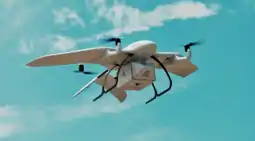eVTOL
eVTOL (electric vertical takeoff and landing) is a type of aircraft that uses electric power to hover, take off, and land vertically. This technology came about thanks to major advances in electric propulsion (motors, batteries, electronic controllers) and the growing need for new vehicles for urban air mobility (air taxi). Examples are in development by companies such as Boeing,[1] NASA, and Airbus.
History
The concept of eVTOL aircraft emerged in 2011 through the AugustaWestland Project Zero (USA), the Volocopter VC1 (Germany) and the Opener BlackFly (USA).[2] It was officially introduced by AHS Internationnal and the American Institute of Aeronautics and Astronautics (AIAA) in 2014 during the "Transformative Vertical Flight Concepts Joint Workshop on Enabling New Flight Concepts through Novel Propulsion and Energy Architectures" held in Virgina (USA).[3]
Since then, there has been a real craze among aircraft manufacturers for eVTOLs, and companies such as Boeing, Airbus and Bell have taken over the market :[4]
- Airbus Vahana introduced in 2017 at the Paris Air Show,[5] first flight in January 2018
- Boeing - Aurora Flight Sciences PAV, in development since 2017, first flight in 2019
- Bell Nexus 6HX unveiled at the CES 2019
But in addition to these major aircraft manufacturers, startups have been playing an important role in the development of these air vehicles and had sometimes been leaders in technological advances.[6]
Uses
Civil use
Most of the civil eVTOL aircraft are designed for urban air mobility, their typical roles are :
Air Taxi
.jpg.webp)
Many eVTOL's concept are for Air Taxi application. For instance, Pipistrel, an Uber Elevate partner, is working on the Pipistrel 801, a 5 seats air taxi.[7] Another example is Volocopter, which proposed its air taxi service called VoloCity, based on the Volocopter 2X .[8]
Medical assistance (EMS)
In 2020, JumpAero announced to be working on a small eVTOL aircraft (1 seat) to allow the rapid deployment of emergency services in the event of an accident. This type of vehicle is not a replacement for land vehicles or helicopters, but a new tool that, thanks to the electric drive, is faster than the others.[9]
In 2020, the Canadian Air Mobility consortium studied the benefits of eVTOL for direct hospital-to-hospital transportation of patients, organs and drugs.[10]
Personal use
Personal eVTOL aircraft have been created to introduce electric flight into recreational aviation.
Unmanned aerial vehicle (UAV)
Unmanned Multicopter were the first aerial vehicle to appear in the eVTOL category. First used for R&D purposes, they are now considered as full-fledged aircraft.[2]
Delivery use
The Google-owned company Alphabet has been offering an eVTOL UAV delivery service since 2020. Their drones are able to fly up to 100 km and carry up to 1.5 kg.[11] Amazon Air and UPS are two others companies using drone delivery .[12] A german aerospace company called Wingcopter in collaboration with UNICEF has also delivered vaccines in Vanuatu in 2018.[13] In 2020 wingcopter eVTOL drone was used to deliver COVID-19 test kits to Isle of Mull.[14]
Military use
In April 2020, the USAF announced $25 million-worth funding of eVTOL projects for development in 2021.[15][16] On August 20, 2020, United States Air Force (USAF) held a demonstration flight of an electric vertical take-off and landing aircraft at Camp Mabry in Austin, Texas. It was the first time that a manned eVTOL aircraft took flight under USAF Agility Prime programme.[15]
Certification
Europe
Since 2018, the European Union Aviation Safety Agency (EASA) has been working on the certification of such aircraft.[17] In July 2019, they published the SC-VTOL-01 : Special Condition for VTOL aircraft. This document established the safety and design objectives for VTOL aircraft. It includes a special section for eVTOL.
United States
The Certification of Small aircraft (Part 23 - FAA certification) is in force. In particular Part 23-Amendment 64 include eVTOL.[18]
References
- "Boeing: Autonomous Flying Taxi: EVTOL Unmanned Solar Aircraft System". www.boeing.com. Retrieved 2020-08-27.
- "eVTOL Timeline". evtol.news. Retrieved 2020-09-23.
- "AHS International Leads Transformative Vertical Flight Initiative". evtol.news. Retrieved 2020-09-23.
- "The eVTOL Industry in Transition". evtol.news. Retrieved 2020-09-23.
- "Paris Air Show: the race for cleaner skies". RFI. 2019-06-21. Retrieved 2020-09-23.
- O'Connor, Kate (12 July 2018). "Opener Reveals Ultralight eVTOL". AVweb. Retrieved 13 July 2018.
- "Pipistrel Unveils eVTOL Concept | Flying Magazine". web.archive.org. 2018-05-13. Retrieved 2020-09-23.
- "Volocopter kicks off pre-sales for its first air taxi flights — with a wait time of 2-3 years". TechCrunch. Retrieved 2020-09-23.
- "Jump Aero". evtol.news. Retrieved 2020-09-23.
- "Searching for Early Use Cases for eVTOL Aircraft". Aviation Today. 2020-08-01. Retrieved 2020-09-23.
- "Drone delivery lands in Queensland's south-east". www.9news.com.au. Retrieved 2020-09-23.
- "After Alphabet's 'Wing', Amazon's 'Prime Air' gets US approval to deliver items through drones". The Economic Times. Retrieved 2020-09-23.
- "Vanuatu awards international drone companies with commercial contracts for vaccine delivery". www.unicef.org. Retrieved 2020-09-28.
- "Wingcopter drone delivering COVID-19 test kits to Isle of Mull". Wings Magazine. 2020-05-27. Retrieved 2020-09-28.
- Reim, Garrett (2020-08-24). "US Air Force leaders watch first Agility Prime eVTOL demonstration". FlightGlobal. Retrieved 2020-08-27.
- Garrett-Glaser, Brian (2020-08-25). "U.S. Air Force Leaders Witness Manned eVTOL Demonstration by LIFT Aircraft's HEXA". Aviation Today. Retrieved 2020-08-27.
- "EASA SC-VTOL". evtol.news. Retrieved 2020-09-23.
- "EASA Releases Next Piece of Regulatory Guidance for Electric Air Taxis". Aviation Today. 2020-05-26. Retrieved 2020-09-23.
